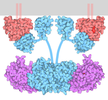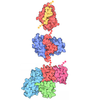+ データを開く
データを開く
- 基本情報
基本情報
| 登録情報 | データベース: PDB / ID: 6q0j | |||||||||
|---|---|---|---|---|---|---|---|---|---|---|
| タイトル | Structure of a MAPK pathway complex | |||||||||
 要素 要素 |
| |||||||||
 キーワード キーワード | Transferase/PROTEIN BINDING / TRANSFERASE / Transferase-PROTEIN BINDING complex | |||||||||
| 機能・相同性 |  機能・相同性情報 機能・相同性情報epithelial cell proliferation involved in lung morphogenesis / negative regulation of homotypic cell-cell adhesion / negative regulation of hypoxia-induced intrinsic apoptotic signaling pathway / positive regulation of endodermal cell differentiation / regulation of vascular associated smooth muscle contraction / CD4-positive, alpha-beta T cell differentiation / positive regulation of axon regeneration / mitogen-activated protein kinase kinase / Golgi inheritance / placenta blood vessel development ...epithelial cell proliferation involved in lung morphogenesis / negative regulation of homotypic cell-cell adhesion / negative regulation of hypoxia-induced intrinsic apoptotic signaling pathway / positive regulation of endodermal cell differentiation / regulation of vascular associated smooth muscle contraction / CD4-positive, alpha-beta T cell differentiation / positive regulation of axon regeneration / mitogen-activated protein kinase kinase / Golgi inheritance / placenta blood vessel development / MAP-kinase scaffold activity / positive regulation of muscle contraction / CD4-positive or CD8-positive, alpha-beta T cell lineage commitment / negative regulation of synaptic vesicle exocytosis / labyrinthine layer development / cerebellar cortex formation / regulation of axon regeneration / melanosome transport / type B pancreatic cell proliferation / Signalling to p38 via RIT and RIN / head morphogenesis / central nervous system neuron differentiation / ARMS-mediated activation / myeloid progenitor cell differentiation / endothelial cell apoptotic process / Signaling by MAP2K mutants / SHOC2 M1731 mutant abolishes MRAS complex function / Gain-of-function MRAS complexes activate RAF signaling / positive regulation of D-glucose transmembrane transport / vesicle transport along microtubule / negative regulation of fibroblast migration / establishment of protein localization to membrane / positive regulation of axonogenesis / positive regulation of Ras protein signal transduction / regulation of Golgi inheritance / mitogen-activated protein kinase kinase kinase binding / triglyceride homeostasis / regulation of T cell differentiation / trachea formation / Negative feedback regulation of MAPK pathway / regulation of early endosome to late endosome transport / mitogen-activated protein kinase kinase binding / regulation of stress-activated MAPK cascade / Frs2-mediated activation / stress fiber assembly / MAPK3 (ERK1) activation / ERBB2-ERBB3 signaling pathway / regulation of neurotransmitter receptor localization to postsynaptic specialization membrane / endodermal cell differentiation / face development / positive regulation of ATP biosynthetic process / MAP kinase kinase activity / Bergmann glial cell differentiation / synaptic vesicle exocytosis / Uptake and function of anthrax toxins / thyroid gland development / protein kinase activator activity / somatic stem cell population maintenance / positive regulation of peptidyl-serine phosphorylation / MAP kinase kinase kinase activity / positive regulation of protein serine/threonine kinase activity / postsynaptic modulation of chemical synaptic transmission / response to glucocorticoid / response to axon injury / negative regulation of endothelial cell apoptotic process / Schwann cell development / response to cAMP / keratinocyte differentiation / positive regulation of stress fiber assembly / ERK1 and ERK2 cascade / myelination / positive regulation of autophagy / positive regulation of substrate adhesion-dependent cell spreading / protein serine/threonine/tyrosine kinase activity / substrate adhesion-dependent cell spreading / dendrite cytoplasm / cellular response to calcium ion / insulin-like growth factor receptor signaling pathway / MAP3K8 (TPL2)-dependent MAPK1/3 activation / thymus development / protein serine/threonine kinase activator activity / animal organ morphogenesis / neuron projection morphogenesis / Signal transduction by L1 / cell motility / positive regulation of transcription elongation by RNA polymerase II / RAF activation / histone H4S1 kinase activity / histone H2BS14 kinase activity / histone H2AS121 kinase activity / histone H3S57 kinase activity / eukaryotic translation initiation factor 2alpha kinase activity / histone H3S28 kinase activity / histone H2AS1 kinase activity / histone H3T6 kinase activity / cellular response to nerve growth factor stimulus / ribosomal protein S6 kinase activity / Spry regulation of FGF signaling / histone H2AT120 kinase activity / histone H2BS36 kinase activity 類似検索 - 分子機能 | |||||||||
| 生物種 |  Homo sapiens (ヒト) Homo sapiens (ヒト) Spodoptera exigua (シロイチモジヨトウ) Spodoptera exigua (シロイチモジヨトウ) | |||||||||
| 手法 | 電子顕微鏡法 / 単粒子再構成法 / クライオ電子顕微鏡法 / 解像度: 4.9 Å | |||||||||
 データ登録者 データ登録者 | Park, E. / Rawson, S. / Jeon, H. / Eck, M.J. | |||||||||
| 資金援助 |  米国, 2件 米国, 2件
| |||||||||
 引用 引用 |  ジャーナル: Nature / 年: 2019 ジャーナル: Nature / 年: 2019タイトル: Architecture of autoinhibited and active BRAF-MEK1-14-3-3 complexes. 著者: Eunyoung Park / Shaun Rawson / Kunhua Li / Byeong-Won Kim / Scott B Ficarro / Gonzalo Gonzalez-Del Pino / Humayun Sharif / Jarrod A Marto / Hyesung Jeon / Michael J Eck /  要旨: RAF family kinases are RAS-activated switches that initiate signalling through the MAP kinase cascade to control cellular proliferation, differentiation and survival. RAF activity is tightly ...RAF family kinases are RAS-activated switches that initiate signalling through the MAP kinase cascade to control cellular proliferation, differentiation and survival. RAF activity is tightly regulated and inappropriate activation is a frequent cause of cancer; however, the structural basis for RAF regulation is poorly understood at present. Here we use cryo-electron microscopy to determine autoinhibited and active-state structures of full-length BRAF in complexes with MEK1 and a 14-3-3 dimer. The reconstruction reveals an inactive BRAF-MEK1 complex restrained in a cradle formed by the 14-3-3 dimer, which binds the phosphorylated S365 and S729 sites that flank the BRAF kinase domain. The BRAF cysteine-rich domain occupies a central position that stabilizes this assembly, but the adjacent RAS-binding domain is poorly ordered and peripheral. The 14-3-3 cradle maintains autoinhibition by sequestering the membrane-binding cysteine-rich domain and blocking dimerization of the BRAF kinase domain. In the active state, these inhibitory interactions are released and a single 14-3-3 dimer rearranges to bridge the C-terminal pS729 binding sites of two BRAFs, which drives the formation of an active, back-to-back BRAF dimer. Our structural snapshots provide a foundation for understanding normal RAF regulation and its mutational disruption in cancer and developmental syndromes. | |||||||||
| 履歴 |
|
- 構造の表示
構造の表示
| ムービー |
 ムービービューア ムービービューア |
|---|---|
| 構造ビューア | 分子:  Molmil Molmil Jmol/JSmol Jmol/JSmol |
- ダウンロードとリンク
ダウンロードとリンク
- ダウンロード
ダウンロード
| PDBx/mmCIF形式 |  6q0j.cif.gz 6q0j.cif.gz | 277.2 KB | 表示 |  PDBx/mmCIF形式 PDBx/mmCIF形式 |
|---|---|---|---|---|
| PDB形式 |  pdb6q0j.ent.gz pdb6q0j.ent.gz | 178.4 KB | 表示 |  PDB形式 PDB形式 |
| PDBx/mmJSON形式 |  6q0j.json.gz 6q0j.json.gz | ツリー表示 |  PDBx/mmJSON形式 PDBx/mmJSON形式 | |
| その他 |  その他のダウンロード その他のダウンロード |
-検証レポート
| 文書・要旨 |  6q0j_validation.pdf.gz 6q0j_validation.pdf.gz | 1 MB | 表示 |  wwPDB検証レポート wwPDB検証レポート |
|---|---|---|---|---|
| 文書・詳細版 |  6q0j_full_validation.pdf.gz 6q0j_full_validation.pdf.gz | 1 MB | 表示 | |
| XML形式データ |  6q0j_validation.xml.gz 6q0j_validation.xml.gz | 40.4 KB | 表示 | |
| CIF形式データ |  6q0j_validation.cif.gz 6q0j_validation.cif.gz | 63.6 KB | 表示 | |
| アーカイブディレクトリ |  https://data.pdbj.org/pub/pdb/validation_reports/q0/6q0j https://data.pdbj.org/pub/pdb/validation_reports/q0/6q0j ftp://data.pdbj.org/pub/pdb/validation_reports/q0/6q0j ftp://data.pdbj.org/pub/pdb/validation_reports/q0/6q0j | HTTPS FTP |
-関連構造データ
- リンク
リンク
- 集合体
集合体
| 登録構造単位 | 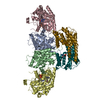
|
|---|---|
| 1 |
|
- 要素
要素
-タンパク質 , 3種, 6分子 ABCDXY
| #1: タンパク質 | 分子量: 89306.812 Da / 分子数: 2 / 変異: S365A / 由来タイプ: 組換発現 / 由来: (組換発現)  Homo sapiens (ヒト) / 遺伝子: BRAF, BRAF1, RAFB1 Homo sapiens (ヒト) / 遺伝子: BRAF, BRAF1, RAFB1発現宿主:  参照: UniProt: P15056, non-specific serine/threonine protein kinase #2: タンパク質 | 分子量: 45934.543 Da / 分子数: 2 / 変異: S218A, S222A / 由来タイプ: 組換発現 / 由来: (組換発現)  Homo sapiens (ヒト) / 遺伝子: MAP2K1, MEK1, PRKMK1 Homo sapiens (ヒト) / 遺伝子: MAP2K1, MEK1, PRKMK1発現宿主:  参照: UniProt: Q02750, mitogen-activated protein kinase kinase #3: タンパク質 | 分子量: 28108.514 Da / 分子数: 2 / 由来タイプ: 天然 由来: (天然)  Spodoptera exigua (シロイチモジヨトウ) Spodoptera exigua (シロイチモジヨトウ)参照: UniProt: V9P4T4 |
|---|
-非ポリマー , 3種, 6分子 

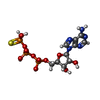


| #4: 化合物 | | #5: 化合物 | #6: 化合物 | |
|---|
-詳細
| 研究の焦点であるリガンドがあるか | Y |
|---|---|
| Has protein modification | Y |
-実験情報
-実験
| 実験 | 手法: 電子顕微鏡法 |
|---|---|
| EM実験 | 試料の集合状態: PARTICLE / 3次元再構成法: 単粒子再構成法 |
- 試料調製
試料調製
| 構成要素 | 名称: ERK pathway complex / タイプ: COMPLEX 詳細: insect cell endogenous 14-3-3 co-purified with human BRAF and MEK Entity ID: #1-#3 / 由来: MULTIPLE SOURCES |
|---|---|
| 分子量 | 値: 325 kDa/nm / 実験値: YES |
| 由来(天然) | 生物種:  Homo sapiens (ヒト) Homo sapiens (ヒト) |
| 由来(組換発現) | 生物種:  |
| 緩衝液 | pH: 7.5 |
| 試料 | 包埋: NO / シャドウイング: NO / 染色: NO / 凍結: YES |
| 急速凍結 | 凍結剤: ETHANE |
- 電子顕微鏡撮影
電子顕微鏡撮影
| 実験機器 | 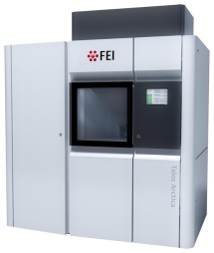 モデル: Talos Arctica / 画像提供: FEI Company |
|---|---|
| 顕微鏡 | モデル: FEI TALOS ARCTICA |
| 電子銃 | 電子線源:  FIELD EMISSION GUN / 加速電圧: 200 kV / 照射モード: OTHER FIELD EMISSION GUN / 加速電圧: 200 kV / 照射モード: OTHER |
| 電子レンズ | モード: OTHER |
| 撮影 | 電子線照射量: 53 e/Å2 / フィルム・検出器のモデル: GATAN K3 (6k x 4k) |
- 解析
解析
| CTF補正 | タイプ: NONE |
|---|---|
| 3次元再構成 | 解像度: 4.9 Å / 解像度の算出法: FSC 0.143 CUT-OFF / 粒子像の数: 425135 / 対称性のタイプ: POINT |
| 原子モデル構築 | プロトコル: RIGID BODY FIT |
 ムービー
ムービー コントローラー
コントローラー



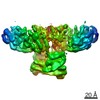



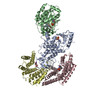
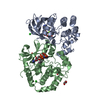



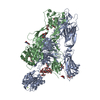

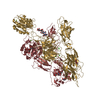

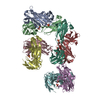
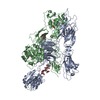
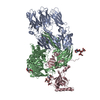
 PDBj
PDBj